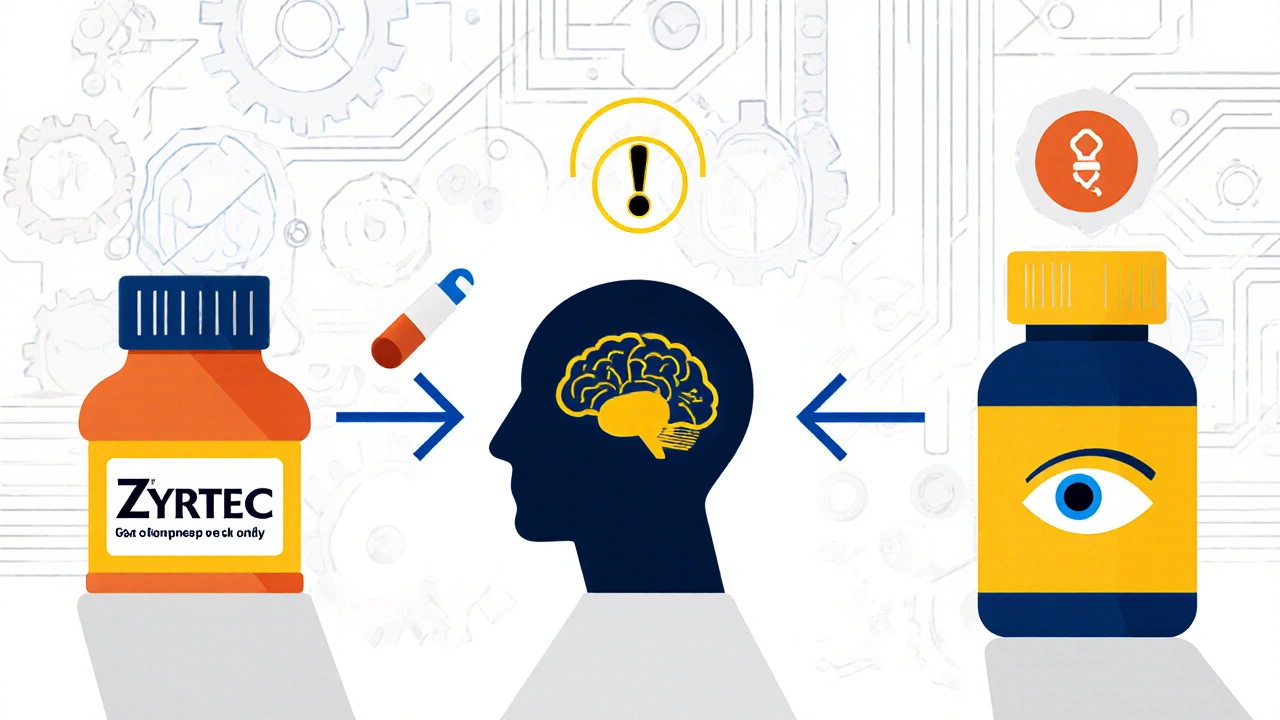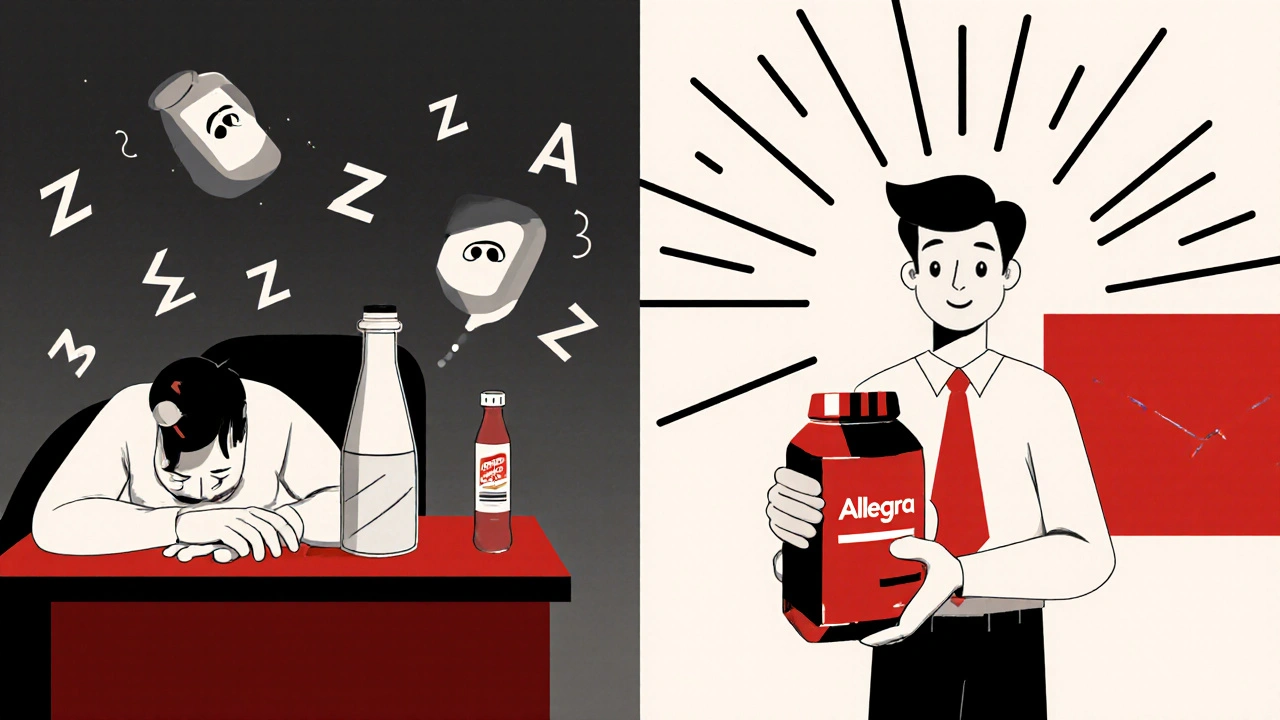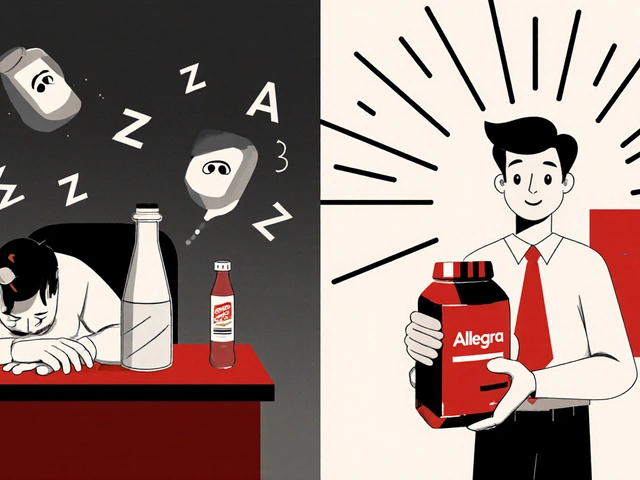When your nose runs, your eyes itch, and sneezing won’t stop, you want relief-fast. But if you’ve ever taken Benadryl and felt like you were drugged for hours, you know the problem: traditional antihistamines make you sleepy. That’s not an option if you’re driving, working, or helping your kid with homework. The good news? There are effective, non-drowsy alternatives that work just as well without the grogginess.
What Makes an Antihistamine Non-Drowsy?
First-generation antihistamines like diphenhydramine (Benadryl) cross into your brain easily, blocking histamine receptors that cause allergy symptoms-but also those involved in wakefulness. That’s why you feel tired. Second- and third-generation antihistamines were designed differently. They’re built to stay out of your brain. How? By being less fat-soluble. That means they can’t slip through the blood-brain barrier the same way. So they block histamine in your nose and eyes, but leave your mind clear.
This isn’t just theory. Clinical studies show that while about 10-15% of people taking cetirizine (Zyrtec) report drowsiness, only 5-7% do with loratadine (Claritin), and fewer than 5% with fexofenadine (Allegra). That’s why doctors often recommend Allegra for pilots, truck drivers, or anyone who needs to stay sharp.
The Top Three Non-Drowsy Options Compared
Three names come up again and again when people ask for non-drowsy allergy relief: Zyrtec, Claritin, and Allegra. All are available over-the-counter in generic forms, which saves money without sacrificing effectiveness.
| Medication (Generic) | Brand Name | Onset of Action | Peak Effect | Duration | Drowsiness Risk | Key Limitation |
|---|---|---|---|---|---|---|
| Cetirizine | Zyrtec | Rapid (within 1 hour) | 1 hour | 24 hours | 10-15% | Can cause drowsiness in some users |
| Loratadine | Claritin | 1-3 hours | 8-12 hours | 24 hours | 5-7% | Weakest for nasal congestion |
| Fexofenadine | Allegra | 1 hour | 2-3 hours | 12-24 hours | <5% | Avoid grapefruit, orange, or apple juice |
Each has trade-offs. Zyrtec works fastest-great if you need quick relief after stepping into pollen-heavy air. But it’s the most likely to make you sleepy, even if you’re not one of the 10-15% who feel it. Claritin is the gentlest on your system but doesn’t help as much with congestion. Allegra is the least sedating, but if you drink orange juice with it, you might as well have taken water. It won’t absorb properly.
Which One Should You Try First?
There’s no universal answer. Your body reacts differently than your neighbor’s. But here’s how to pick your starting point:
- If you need fast relief and don’t mind testing for drowsiness → Try cetirizine (Zyrtec). Take it at night first to see how you respond.
- If you’re in a safety-critical job (driver, operator, student) → Start with fexofenadine (Allegra). It’s the safest bet for staying alert.
- If you’ve tried others and nothing worked → Go with loratadine (Claritin). It’s the most forgiving if you’re sensitive to side effects.
Many people find that one works well for a while, then stops being as effective. That’s normal. Allergies change with seasons, environment, and even stress levels. If one stops working after a few weeks, switch to another. No need to stick with something that’s losing its punch.

What About Xyzal and Clarinex?
You might see Xyzal (levocetirizine) or Clarinex (desloratadine) on the shelf. These are the active ingredients in Zyrtec and Claritin, but purified. Xyzal is the pure form of cetirizine-meaning it’s slightly more potent. Studies show it may offer a small edge in reducing sneezing and runny nose compared to regular Zyrtec. But it’s also more expensive, and the difference is subtle. For most people, generic cetirizine works just fine.
Clarinex is the active metabolite of loratadine. It’s stronger than Claritin, but again, the price jump isn’t worth it for most. Generic loratadine is cheaper, widely available, and still effective. Unless you’ve tried everything else and still struggle, stick with the basics.
What You Should Avoid
Some people reach for combination products like Zyrtec-D, Claritin-D, or Allegra-D because they promise faster relief from congestion. These add pseudoephedrine, a decongestant. It works-but it comes with side effects: faster heartbeat, jitteriness, trouble sleeping, and higher blood pressure. If you have heart problems, high blood pressure, or anxiety, skip these. You’re trading one problem for another.
Also, avoid taking Allegra with grapefruit, orange, or apple juice. These juices block an enzyme your body needs to absorb fexofenadine. The result? You get almost no benefit. Always take Allegra with water. Same goes for Zyrtec and Claritin-no juice needed, but no harm if you drink it afterward.
Cost and Accessibility
Generic versions of all three are cheap. In 2025, you can get 90 tablets of generic cetirizine for under $10 at Walmart or Costco. Generic loratadine is around $12. Fexofenadine is still the priciest at $18-$20 for 90 tablets-but even that’s less than $0.25 per dose.
Brand names cost 2-3 times more. Zyrtec brand might be $25 for 90 tablets. Why pay extra? The active ingredient is identical. The only difference is packaging and marketing. Stick with generics unless you have a specific reason not to.

When Antihistamines Aren’t Enough
If you’re taking these daily for weeks and still feel congested, it might not be histamine causing the problem. Antihistamines are great for sneezing, itching, and runny nose. But they don’t do much for nasal blockage. That’s where nasal corticosteroids like Flonase or Nasacort come in. These sprays reduce inflammation directly in your nasal passages. They take a few days to build up, but they’re far more effective for congestion than any antihistamine.
Doctors often recommend using a nasal spray alongside a non-drowsy antihistamine for full control. If you’ve been relying on antihistamines alone and still feel stuffed up, it’s time to add a steroid spray. It’s not a replacement-it’s a complement.
Real-Life Tips from People Who Use Them Daily
- Take Zyrtec at night if you feel even a little sleepy. Most people don’t notice drowsiness the next day if they take it before bed.
- Keep Claritin on hand for mild allergies. It’s the most predictable, even if it’s not the strongest.
- Always carry Allegra with water if you’re traveling. You never know when you’ll need it-and you don’t want to be stuck with juice that ruins it.
- Don’t switch brands every week. Give each one at least 3-5 days to work before deciding it’s not right for you.
- Ask your pharmacist. They can check for interactions with your other meds and suggest the best value option.
Final Thought: There’s No Perfect Pill
Everyone’s body responds differently. What works perfectly for one person might do nothing for another. That’s why trying a few options isn’t a failure-it’s smart. The goal isn’t to find the "best" antihistamine. It’s to find the one that keeps your symptoms under control without slowing you down.
And if none of them work? Talk to an allergist. You might need testing to find out what you’re really allergic to. Sometimes, avoiding triggers-like pollen, dust mites, or pet dander-is more effective than any pill.
Are non-drowsy antihistamines really non-sedating?
They’re designed to be non-sedating, but they’re not 100% guaranteed to avoid drowsiness. About 10-15% of people taking Zyrtec report feeling sleepy, while fewer than 5% do with Allegra. Individual reactions vary based on metabolism, age, and other medications. Always test a new antihistamine when you don’t need to drive or operate machinery.
Can I take non-drowsy antihistamines every day?
Yes, all three main options-cetirizine, loratadine, and fexofenadine-are approved for daily, long-term use. Many people take them during allergy season or year-round if they have chronic allergies. They’re safer than first-generation antihistamines for daily use. Still, if you’re using them for more than 3 months without relief, talk to a doctor.
Is Allegra really the best choice?
For people who need to stay alert-like drivers, pilots, or shift workers-Allegra (fexofenadine) is often the top pick because it doesn’t cross the blood-brain barrier. Clinical studies show it has the lowest risk of drowsiness. But it’s not necessarily the most effective for all symptoms. If congestion is your main issue, it may not help as much as Zyrtec or a nasal spray.
Why does grapefruit juice affect Allegra?
Grapefruit, orange, and apple juice block an enzyme called OATP1A2 in your gut that helps absorb fexofenadine. Without it, the medication doesn’t enter your bloodstream properly. You’ll still take the pill, but your body won’t use it. Always take Allegra with plain water to ensure full effectiveness.
Do I need a prescription for these?
No. Cetirizine, loratadine, and fexofenadine are all available over-the-counter in the U.S., Australia, and many other countries. You can buy them without a prescription at any pharmacy. Generic versions are just as effective as brand names and often cost less than half.
Can children take non-drowsy antihistamines?
Yes. All three are approved for children as young as 2 years old, usually in liquid or chewable forms. Always check the label for age-appropriate dosing. For kids under 6, consult a pediatrician before starting regular use.
What if I still feel tired after switching?
If you’re still drowsy after switching to Allegra or Claritin, the issue might not be the antihistamine. Other causes could include poor sleep, stress, or other medications like antidepressants or blood pressure pills. Talk to your doctor about your full medication list. You might need to adjust something else.








Frank Dahlmeyer November 20, 2025
Man, I’ve been on Zyrtec for years and thought I was one of those lucky ones who didn’t get sleepy-until I tried driving home after a long day at the office. Felt like I was underwater. Switched to Allegra and now I’m back to being a human again. No joke, I even started biking to work during pollen season. The juice thing? Total game-changer. I used to chug orange juice with breakfast and wonder why my allergies weren’t improving. Now I drink water like a monk. Small changes, big results.
Also, if you’re on a budget, generic cetirizine at Costco is literally a dollar a pill. I buy the 90-count and it lasts me through spring and fall. No need to overpay for fancy packaging. The pill doesn’t care if it’s in a fancy bottle or a plain box.
And yeah, Claritin’s fine for mild stuff, but if you’re battling full-on hay fever? It’s like bringing a water pistol to a wildfire. Zyrtec hits hard. Allegra hits clean. Pick your weapon.
Also, don’t ignore nasal sprays. I thought antihistamines were the end-all-be-all until I tried Flonase. Suddenly, I could breathe through my nose again. Like, actually breathe. Not just sniff like a dog. That’s when I realized: antihistamines don’t fix congestion. They just make you stop sneezing. The spray fixes the root. Use both. Together. Like peanut butter and jelly. But for your sinuses.
Codie Wagers November 20, 2025
Let’s be precise: the term ‘non-drowsy’ is a marketing construct, not a physiological guarantee. The pharmacokinetic profile of second-generation antihistamines reduces, but does not eliminate, CNS penetration. The blood-brain barrier is not an impenetrable fortress-it’s a semi-permeable membrane subject to individual variability in P-glycoprotein expression, hepatic metabolism, and genetic polymorphisms in CYP3A4. Therefore, claiming that ‘fewer than 5%’ experience drowsiness is statistically misleading when the sample populations in clinical trials are often skewed toward healthy adults, excluding elderly, metabolically compromised, or polypharmacy patients.
Furthermore, the assertion that Allegra is ‘least sedating’ is contingent on co-ingestion of water. The inhibition of OATP1A2 by citrus flavonoids is a well-documented, peer-reviewed phenomenon. To suggest that ‘no harm’ comes from drinking juice afterward is not only inaccurate-it’s dangerous. The drug’s bioavailability drops by up to 70%. This is not a minor inconvenience. It is pharmacological sabotage.
And while we’re at it: the recommendation to ‘try Zyrtec at night’ is a band-aid solution. If your medication is sedating, it’s not ‘working better’-it’s still affecting your CNS. You’re not optimizing-you’re compensating. The goal isn’t to schedule your drowsiness. It’s to eliminate it.
Reema Al-Zaheri November 21, 2025
Thank you for the detailed breakdown. I have chronic allergic rhinitis and have tried all three generics over the past five years. I can confirm: Allegra with water is the only one that allows me to work 12-hour shifts without fatigue. Zyrtec made me feel like I’d been sedated; Claritin did nothing for my nasal congestion. The grapefruit juice warning is critical-I once took Allegra with apple juice and spent three hours wondering why my symptoms didn’t improve. It wasn’t the allergy. It was the juice.
Also, I’ve noticed that taking antihistamines with food slows absorption. I take them on an empty stomach now, and the onset is noticeably faster. For anyone who says, ‘It doesn’t matter,’ it does. The pharmacokinetics are clear. Timing matters.
Lastly, I agree with the nasal spray recommendation. I use Flonase daily during high-pollen months. It’s not instant, but after three days, my sinuses feel like they’ve been cleaned with a pressure washer. Antihistamines alone are like wiping a foggy mirror. Steroid sprays are the squeegee.
harenee hanapi November 22, 2025
Ugh. I can’t believe people still fall for this ‘non-drowsy’ nonsense. I took Claritin for two years thinking I was fine-until I fell asleep at my kid’s soccer game. I was sitting on the bleachers. I didn’t even realize I’d passed out until my husband shook me. My daughter cried because she thought I was dead.
Then I tried Zyrtec. Same thing. Then Allegra. Same. I thought maybe I was broken. Turns out, I’m just sensitive. And now I’m stuck with saline sprays and humidifiers because ‘science’ says these pills are safe. Safe for who? Not for me. Not for my kid. Not for the people who drive next to me when I’m zoning out.
Why is no one talking about this? Why is everyone just nodding along like it’s a miracle? It’s not. It’s a lie wrapped in a clinical study.
And now I’m out $80 on generics that made me a danger to myself and others. Thanks, Big Pharma.
Christopher Robinson November 24, 2025
Just wanted to say thanks for this post-it’s the most useful thing I’ve read about allergies in years. 🙌
I’m a teacher, and I used to rely on Benadryl during spring. Then I’d zone out during parent-teacher conferences. Not ideal. Switched to Allegra with water (no juice, ever) and now I’m actually present. I even started recommending it to my coworkers.
Also, the nasal spray tip? Game changer. I started using Flonase last year and now I can actually smell my coffee again. Who knew? 😅
And yes, generics are the way to go. I bought 90 of the cheapest cetirizine on Amazon for $8.50. Same pill, zero branding. I’m not paying for a logo.
Biggest takeaway: don’t give up after one try. Your body changes. Your allergies change. Your meds might need to change too. Try, adjust, repeat. No shame in that.
river weiss November 25, 2025
It is imperative to underscore the importance of medication adherence and environmental control in the management of allergic rhinitis. While pharmacological intervention provides symptomatic relief, it does not constitute a curative modality. The integration of non-pharmacological strategies-including HEPA filtration, avoidance of known allergens, and humidification of indoor environments-should be considered as foundational components of a comprehensive therapeutic plan.
Furthermore, the assertion that antihistamines are ‘safe for daily use’ requires contextual qualification. Long-term, continuous administration may lead to receptor downregulation, diminished efficacy, and potential rebound effects upon discontinuation. Therefore, periodic reassessment by a qualified healthcare provider is recommended at intervals not exceeding three months.
Additionally, the concomitant use of nasal corticosteroids is not merely complementary; it is synergistic. The mechanism of action-reduction of inflammatory cytokines in the nasal mucosa-is fundamentally distinct from histamine receptor antagonism. Consequently, the combination therapy represents the current standard of care for persistent moderate-to-severe allergic rhinitis.
Lastly, the cost differential between brand and generic formulations is not a matter of marketing alone; it reflects regulatory, manufacturing, and distribution efficiencies. Generic drugs, by definition, are bioequivalent. Therefore, economic prudence and therapeutic efficacy are not mutually exclusive. One may be both fiscally responsible and medically optimal.
Brian Rono November 25, 2025
Oh wow, another glowing ode to Big Pharma’s ‘non-drowsy’ fairy dust. Let me guess-next you’ll tell me that ‘sugar-free’ soda doesn’t make you fat and ‘organic’ chips are good for your kidneys.
Here’s the truth no one wants to say: these drugs are barely better than Benadryl. They just have fancier labels and higher price tags. I’ve taken all three. All of them made me sluggish. All of them left me with a weird brain fog. And yes, I drank water with Allegra. Still felt like I’d been hit by a pillow full of cement.
And the ‘10-15%’ drowsiness stat? That’s the tip of the iceberg. That’s the number they report to the FDA. The real number? The number of people who say ‘I feel fine’ but can’t focus, can’t remember names, can’t drive safely? That’s 40%. Maybe 50%.
And don’t even get me started on the ‘just switch to another one’ advice. That’s not medicine. That’s gambling. And your kid’s safety? Your job? Your license? You’re betting all of that on a coin flip.
Real solution? Avoid allergens. Clean your house. Wash your sheets. Use a neti pot. Stop pretending a pill is magic. It’s not. It’s just a chemical distraction.
Zac Gray November 26, 2025
Okay, real talk: I used to be the guy who took Zyrtec every morning and pretended I was fine. Then I got pulled over for swerving. Not drunk. Just… gone. Like my brain had been unplugged.
Switched to Allegra. Took it at night. Didn’t drink juice. Used Flonase. And guess what? I didn’t crash my car. I didn’t fall asleep during my Zoom calls. I didn’t miss my daughter’s piano recital because I was passed out on the couch.
It’s not glamorous. It’s not a miracle. But it’s a system. And systems beat luck.
Also, I used to think ‘just take it at night’ was a cop-out. Turns out, it’s not. It’s smart. You’re not avoiding the side effect-you’re managing it. Like putting a bandage on a cut instead of hoping it heals by itself.
And yeah, generics are fine. I buy mine at the dollar store. Same pill. Different bag. No one’s going to arrest you for being cheap. They’ll arrest you for driving while drowsy.
Steve and Charlie Maidment November 28, 2025
Wow. So much information. I read all of it. And then I just… forgot what I was supposed to do. I think I’m allergic to reading. Or maybe I’m just tired. Or maybe it’s the antihistamine. Or maybe I’m just… not smart enough to understand this.
Can someone just tell me what to take? Like, in one sentence? Because I’ve been reading this for 20 minutes and I still don’t know if I should take Zyrtec or if I’m supposed to avoid orange juice or if I need to buy a whole new life.
Also, I’m pretty sure I took Allegra with apple juice last week. I think I’m dying.
Can someone just tell me what to do? I’m not asking for a thesis. I’m asking for a lifeline.
Frank Dahlmeyer November 29, 2025
One sentence: Start with generic fexofenadine (Allegra), take it with water, use Flonase daily, and if you’re still stuffed up after a week, see an allergist. No juice. No rush. No drama.
And if you’re still tired? It’s not the pill. It’s your sleep. Or your stress. Or your diet. Or all three. But it’s not the antihistamine’s fault. You just didn’t give it the right setup.